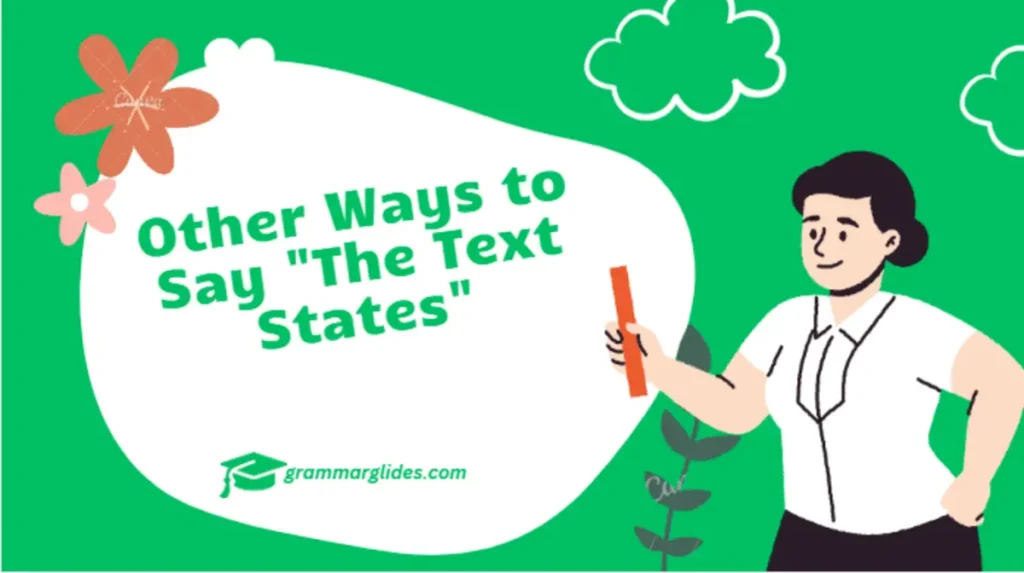“Looking for alternatives to “the text states”? Here are 30 different phrases to convey the same message effectively!‘
In writing, particularly in academic and professional settings, it’s crucial to articulate ideas clearly and precisely. Phrases like “the text states” are commonly used to introduce quotes or references, but using the same phrase repeatedly can become monotonous.
To enhance your writing and keep your audience engaged, it’s beneficial to have a variety of expressions at your disposal. Here are 30 alternative phrases to use instead of “the text states” that can add variety and clarity to your writing.
1. The Text Indicates
Scenario: Introducing a quote from a research paper.
Example 1: “The text indicates a strong correlation between the two variables.”
Example 2: “According to the text, the findings support the hypothesis.”
Explanation: This phrase effectively conveys that the text points to a specific idea or conclusion.
2. The Author Notes

Scenario: Referring to insights from a book.
Example 1: “The author notes that environmental factors significantly impact behavior.”
Example 2: “In her analysis, the author notes the importance of historical context.”
Explanation: This phrase attributes the information directly to the author’s observation or commentary.
3. The Passage Reveals
Scenario: Analyzing a specific section of literature.
Example 1: “The passage reveals the complexities of human emotions.”
Example 2: “This passage reveals the author’s perspective on societal issues.”
Explanation: This expression highlights the insights or themes presented in a particular excerpt.
4. The Text Suggests
Scenario: Summarizing findings from a report.
Example 1: “The text suggests that increased training can improve employee performance.”
Example 2: “The report suggests several strategies for effective communication.”
Explanation: This phrase indicates a recommendation or implication derived from the text.
5. The Document States

Scenario: Citing a formal report or document.
Example 1: “The document states that all participants must comply with safety regulations.”
Example 2: “According to the document, the project deadline has been extended.”
Explanation: This is a direct way to reference information found in an official document.
6. The Text Clarifies
Scenario: Explaining a complex idea.
Example 1: “The text clarifies that not all variables were considered in the study.”
Example 2: “This section of the text clarifies the author’s main argument.”
Explanation: This phrase indicates that the text provides additional understanding or context.
7. The Author Argues
Scenario: Presenting a controversial viewpoint.
Example 1: “The author argues that traditional methods are no longer effective.”
Example 2: “In the conclusion, the author argues for a paradigm shift in the field.”
Explanation: This phrase emphasizes a point of view put forth by the author.
8. The Text Emphasizes
Scenario: Highlighting key points in an argument.
Example 1: “The text emphasizes the need for sustainable practices.”
Example 2: “The article emphasizes the role of technology in education.”
Explanation: This phrase underscores the importance of specific information within the text.
9. The Author Explains
Scenario: Providing a detailed analysis.
Example 1: “The author explains the implications of the study in great detail.”
Example 2: “In the introduction, the author explains the rationale behind the research.”
Explanation: This phrase indicates that the author provides clarity on a topic.
10. The Text Addresses
Scenario: Discussing a particular subject within the text.
Example 1: “The text addresses the challenges faced by small businesses.”
Example 2: “This chapter addresses the ethical considerations of the study.”
Explanation: This phrase indicates that the text focuses on a specific topic or issue.
11. The Text Reports
Scenario: Referring to findings in a survey.
Example 1: “The text reports that 75% of respondents favored the new policy.”
Example 2: “The research text reports significant differences between the groups.”
Explanation: This phrase is useful for summarizing statistical or survey findings.
12. The Document Indicates
Scenario: Discussing findings in an official report.
Example 1: “The document indicates a need for further research.”
Example 2: “This document indicates that the budget has been approved.”
Explanation: Similar to “the text indicates,” this phrase specifies that information comes from a formal document.
13. The Author Claims
Scenario: Presenting a bold assertion.
Example 1: “The author claims that the current system is outdated.”
Example 2: “In his findings, the author claims to have discovered new evidence.”
Explanation: This phrase conveys a strong statement made by the author.
14. The Text Reveals
Scenario: Discussing underlying themes in literature.
Example 1: “The text reveals deep-seated fears within the characters.”
Example 2: “This analysis reveals the author’s critique of modern society.”
Explanation: This phrase suggests that the text exposes or uncovers deeper meanings.
Other Ways to Say “Happy Birthday”
15. The Passage States
Scenario: Introducing a quote from a specific section.
Example 1: “The passage states that teamwork enhances productivity.”
Example 2: “In the passage, it states the importance of ethics in research.”
Explanation: This phrase is a direct way to reference a specific excerpt or passage.
16. The Research Shows
Scenario: Summarizing findings from a study.
Example 1: “The research shows a clear link between exercise and mental health.”
Example 2: “This research shows significant improvements in student performance.”
Explanation: This phrase emphasizes findings derived from empirical research.
17. The Text Illustrates
Scenario: Providing examples from a study.
Example 1: “The text illustrates the impact of climate change on agriculture.”
Example 2: “This section of the text illustrates various teaching methods.”
Explanation: This phrase indicates that the text provides specific examples or case studies.
18. The Author Describes
Scenario: Detailing an important concept.
Example 1: “The author describes the challenges faced by urban communities.”
Example 2: “In her book, the author describes the process of innovation.”
Explanation: This phrase indicates that the author provides a detailed explanation.
19. The Text Supports
Scenario: Citing evidence that backs up a claim.
Example 1: “The text supports the argument that early intervention is crucial.”
Example 2: “This study supports the theory of evolution.”
Explanation: This phrase indicates that the text provides evidence to reinforce a point.
20. The Document Affirms
Scenario: Citing confirmation of a policy.
Example 1: “The document affirms the commitment to diversity and inclusion.”
Example 2: “This document affirms the organization’s values and mission.”
Explanation: This phrase highlights that the document confirms or validates specific information.
21. The Text Demonstrates
Scenario: Providing a clear example of a concept.
Example 1: “The text demonstrates the effectiveness of the new approach.”
Example 2: “This section demonstrates the consequences of neglecting mental health.”
Explanation: This phrase indicates that the text showcases or illustrates specific ideas.
22. The Research Indicates
Scenario: Citing results from a scientific study.
Example 1: “The research indicates that a balanced diet improves health.”
Example 2: “This research indicates a rise in remote work productivity.”
Explanation: This phrase is similar to “the text indicates” but specifically refers to research findings.
23. The Text Warns
Scenario: Citing cautionary information.
Example 1: “The text warns against the dangers of misinformation.”
Example 2: “This section warns that neglecting safety protocols can have serious consequences.”
Explanation: This phrase emphasizes caution and highlights potential risks.
24. The Author Observes
Scenario: Highlighting an insightful comment.
Example 1: “The author observes that social media can influence public opinion.”
Example 2: “In her analysis, the author observes the shifts in consumer behavior.”
Explanation: This phrase emphasizes the author’s careful examination of a topic.
25. The Text Clarifies
Scenario: Providing essential context.
Example 1: “The text clarifies the relationship between cause and effect.”
Example 2: “This section clarifies the definition of key terms.”
Explanation: This phrase indicates that the text provides important clarification on a subject.
26. The Study Finds

Scenario: Discussing research outcomes.
Example 1: “The study finds a direct correlation between stress and health.”
Example 2: “This study finds that early exposure to reading enhances literacy skills.”
Explanation: This phrase emphasizes the conclusions drawn from specific studies.
27. The Text Advocates
Scenario: Presenting a persuasive argument.
Example 1: “The text advocates for policy changes to protect the environment.”
Example 2: “This text advocates for a more inclusive education system.”
Explanation: This phrase indicates that the text strongly supports a specific viewpoint.
28. The Document Summarizes
Scenario: Referring to key points in a report.
Example 1: “The document summarizes the findings of the annual review.”
Example 2: “This document summarizes the main recommendations for improvement.”
Explanation: This phrase highlights that the document distills essential information.
29. The Text Expounds
Scenario: Offering detailed information on a topic.
Example 1: “The text expounds on the significance of cultural heritage.”
Example 2: “This section expounds on the theories of economic development.”
Explanation: This phrase indicates that the text elaborates on specific concepts.
30. The Author Suggests
Scenario: Providing recommendations based on findings.
Example 1: “The author suggests adopting a collaborative approach to problem-solving.”
Example 2: “In her conclusion, the author suggests further exploration of the topic.”
Explanation: This phrase conveys that the author is offering recommendations for future actions.
Conclusion
Using varied expressions instead of “the text states” can greatly enhance your writing. With these 30 alternative phrases, you can enrich your vocabulary and improve the flow of your work. Choose the phrases that best fit your context, and elevate your writing today!

Hi! I’m Lauren Reynolds, the author of Grammar Glides. I create easy-to-follow content that helps you master English with confidence. Let’s make learning English simple and enjoyable together!

